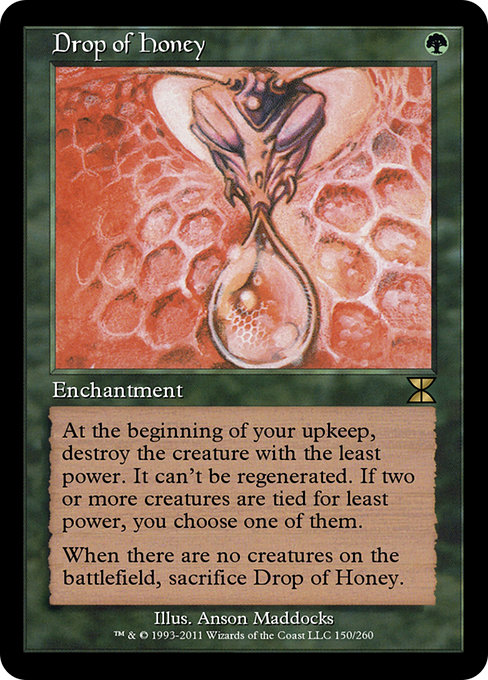
Image courtesy of Scryfall.com
Worldbuilding Seeds from Drop of Honey: Bee-Inspired Lore and Flavor
Green enchantments in Magic have a way of whispering about growth, balance, and the quiet ways nature keeps itself in check 🧙♂️. Drop of Honey is no exception. While it sits on the battlefield like a polite plant until upkeep, its power is inseparable from a hive’s moral compass: prune what’s weakest, protect what’s essential, and let life cycle forward in measured steps 🔥. The card’s text invites writers and game designers to imagine a hive culture where power is not blunt force but a measured, almost ceremonial, trimming. In a narrative sense, this enchantment becomes a fable of harmony and consequence, a mechanic that doubles as worldbuilding fuel for a beeyard civilization—and it does so with the quiet confidence of a well-waxed honeycomb 🎨.
Drop of Honey is green, a color that Magic fans rightly associate with growth, ecosystems, and the patient work of provisioning life. Its upkeep trigger—destroy the creature with the least power—reads as a living law of the hive: the colony maintains its vitality by gently culling the fringe, those drones or wanderers whose presence risks unbalancing the brood. The fact that it cannot be regenerated adds a stark, almost ceremonial gravity to the act; in a story, this could be a ritual sacrifice performed by caretakers who read the battlefield like a field diary, noting the ever-changing dynamics of strength and weakness. When there are no creatures left, the enchantment itself is sacrificed, signaling a seasonal reset of the ecosystem. The hive cycles through life, death, and renewal, and the card encodes that rhythm in a single green enchantment 🌿.
“In the hive, every brood has its season, and every season has its measure. The smallest light of life must be tended, or the whole hive grows thin.”
Worldbuilding prompts inspired by the card's lore
- Hierarchy by power: Create a society where status is not wealth or bravado but the potency of one’s smallest ally. In such a world, scouts, gatherers, and caretakers coordinate to keep the stingy few from tipping the balance, echoing the card’s tiered destruction in a larger governance system.
- Ecology of honey and habitat: Imagine hexagonal cities carved into living hives: waxy towers, pollen-driven energy, and honey as both resource and currency. Vendors accept honey-based notes with wax seals; pollinators are honored as artisans and engineers.
- Ritual of upkeep: The hive conducts a monthly or seasonal rite where the least powerful creature is evaluated and, if needed, released from the stage to maintain the colony’s trajectory. This ritual could be observed by travelers as a sign of a thriving, disciplined community 🧙♂️.
- Conflict and resolution: When two or more creatures share the least power, the hive elects one to be removed, creating a natural arena for courtroom-style storytelling—debate, alliances, and the politics of mercy and necessity ⚔️.
- End-of-life cycles: The moment when there are no creatures on the battlefield triggers a sacrifice of the enchantment, a symbolic death that clears the slate for the next bloom of life, inviting stories about renewal and reclamation 🔄.
In crafting a world around Drop of Honey, consider weaving in motifs of pollination as social currency, queenly authority as the hive’s legal framework, and foraging ethics as a public policy. The aesthetic sings a gentle, almost Ubisoft-level loot-note of discovery: amber-lit tunnels, shimmering pollen markets, and beelike artisans who craft with precision and care 🎲. This isn’t just flavor text; it’s an invitation to design ecosystems where growth isn’t reckless conquest but a choreography of cooperation and restraint 🔎💎.
Design angles for gameplay and storytelling
If you’re building a deck or a lore-rich game world around this concept, lean into the tension between abundance and scarcity. The little-known creatures that hover at the bottom of the power scale become the story’s protagonists—facing a hive’s “upkeep” head-on. You can pair Drop of Honey with other green effects that reward careful board development, such as tokens of growth, sapling creatures, or forest guardians who enforce a similar balance. The interplay between a single, strategic removal and a broader ecosystem-wide design challenge makes for memorable play experiences and narrative moments 🧙♂️🔥.
Artwork and flavor direction matter, too. The Me4 Masters Edition IV frame and its card art by Anson Maddocks—though a vintage piece—carries a timeless feel: nature as grand architecture, honeyed light filtering through hexagonal corridors, and a quiet, almost ceremonial, menace. Translating that vibe to new artwork could emphasize the protective, life-sustaining role of bees, or flip the lens to a cunning hive mind that respects strength but curates life with mercy and precision. In either case, color, texture, and symbol—honeycomb geometry, pollen flecks, and the green mana glyph—serve as anchors for storytelling and game design alike ⚔️🎨.
For players and writers collaborating on a shared world, Drop of Honey offers a compact rule-set metaphor: balance achieved through deliberate pruning, continual renewal, and the resilience of a community that thrives on cooperation. It can inspire a regional mythos—the Honeyed Dominion—where forests are peppered with terraced hives and citizen-beekeepers act as stewards of ecological law. The card becomes a touchstone you can return to when debating how a society measures strength and what it means to protect the fragile, essential workers that keep life buzzing 🐝.
Rugged Phone Case – Impact Resistant Glossy TPU ShellMore from our network
- https://blog.digital-vault.xyz/blog/post/rakdos-carnarium-breaks-mtg-design-conventions/
- https://transparent-paper.shop/blog/blog/post/create-stunning-seasonal-invitation-templates-in-minutes/
- https://blog.digital-vault.xyz/blog/post/board-the-weatherlight-unseen-artifact-synergies-from-lesser-known-cards/
- https://blog.digital-vault.xyz/blog/post/designing-guild-feud-for-diverse-mtg-playstyles/
- https://blog.digital-vault.xyz/blog/post/decoding-narrative-hints-in-kavu-aggressors-art/